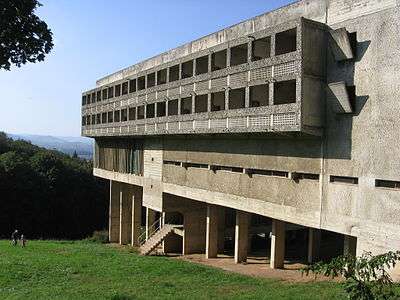Sainte Marie de La Tourette
| Convent Sainte-Marie de La Tourette | |
|---|---|
 | |
| General information | |
| Type | Convent |
| Architectural style | Modernist, International |
| Town or city | Éveux, Rhône-Alpes |
| Country | France |
| Construction started | 1956 |
| Completed | 1960 |
| Renovated | 1981 |
| Design and construction | |
| Architect | Le Corbusier |
| Website | |
| http://www.couventlatourette.com/ | |
| Official name | The Architectural Work of Le Corbusier, an Outstanding Contribution to the Modern Movement |
| Type | Cultural |
| Criteria | i, ii, vi |
| Designated | 2016 (40th session) |
| Reference no. | 1321-015 |
| State Party | France |
Sainte Marie de La Tourette is a Dominican Order priory on a hillside near Lyon, France designed by architects Le Corbusier and Iannis Xenakis and constructed between 1956 and 1960. Le Corbusier's design of the building began in May, 1953 with sketches drawn at L'Arbresle, France outlining the basic shape of the building and terrain of the site.[1] La Tourette is considered one of the most important buildings of the late Modernist style.
In July 2016, the building and several other works by Le Corbusier were inscribed as UNESCO World Heritage Sites.[2]
Architecture
Under the instigation of Marie-Alain Couturier the Dominicans of Lyon charged Le Corbusier with the task of constructing the priory on a hillside at Éveux, near Lyon.
The buildings contain a hundred bedrooms for teachers and students, study halls, a hall for work and one for recreation, a library and a refectory. There is also a church, where the friars worship, and the circulation, which connects all the parts (the achievement of the traditional cloister form is rendered impossible here by the slope of terrain). On two levels, the loggias crowning the building (one for each acoustically isolated monk's cell) form brises-soleil. The study halls, work and recreation halls, as well as the library occupy the upper-level. Below are the refectory and the cloister in the form of a cross leading to the church. And then come the piles carrying the four convent buildings rising from the slope of the terrain left in its original condition, without terracing.
The structural frame is of rough reinforced concrete. The panes of glass located on the three exterior faces, the so-called "pans de verre ondulatoire" ("undulating glass surfaces"), were designed by Xenakis, and are similar to those of the Secretariat at Chandigarh on which Xenakis also worked. On the other hand, in the garden-court of the cloister, the fenestration is composed of large concrete elements reaching from floor to ceiling, perforated with glazed voids and separated from one another by "ventilators": vertical slits covered by metal mosquito netting and furnished with a pivoting shutter. The corridors leading to the dwelling cells are lit by a horizontal opening located under the ceiling.
Built as a chapel, residence and place of learning for Dominican friars, the monastery groups around a central courtyard a U-shaped mass, and the court is closed off by the chapel at the end.
At La Tourette many aspects of Corbusier's developed architectural vocabulary are visible – the vertical brise-soleils used with effect in India, light-cannons piercing solid masonry walls, and window-openings separated by Modulor-controlled vertical divisions. In contrast with Ronchamp, the building does not crown and complement the site, but instead dominates the landscape composition.
If there is harmony, it is in the finishes that in their roughness and near-brutality betray some empathy with the life of a friar. La Tourette makes no claim to the effete bourgeois lifestyle embodied at the Villa Savoye; its antecedents, if anything, are the Greek monasteries of Mount Athos and an almost mythological history.
At the Couvent de la Tourette (1960), Le Corbusier found an echo, in an architectural project, of the personal principles of self-denial and monastic simplicity that he himself adhered to.
Though still functioning for a reduced population of friars, La Tourette has, like Ronchamp, become something of a pilgrimage site for students of architecture. The priory allows overnight stays in the unused cells. Fees for the room go to maintenance of the priory.
References
- ↑ Philippe Potié (2001). Le Corbusier:Le Couvent Sainte Marie da la Tourette. Birkhauser Publishers. ISBN 3-7643-6298-7; page 64
- ↑ "The Architectural Work of Le Corbusier". UNESCO World Heritage Centre. United Nations Educational, Scientific and Cultural Organization. Retrieved 19 July 2016.
- Potié, Philippe (2001). Le Corbusier:Le Couvent Sainte Marie da la Tourette. Basel, Switzerland:Birkhauser. ISBN 3-7643-6298-7.
- Boesiger, Willy (editor) (1996). Le Corbusier: Complete Works (8 volumes). Cambridge, Mass.:Birkhauser. ISBN 3-7643-5515-8.
- Baker, Geoffrey H. (1984). Le Corbusier: An Analysis of Form. New York: Van Nostrand Reinhold. ISBN 0-442-30557-5.
- Gans, Deborah (1987). The Le Corbusier Guide. Princeton: Princeton Architectural Press. ISBN 0-910413-23-1.
- Curtis, William J R (1986). Le Corbusier: Ideas and Forms. Oxford: Phaidon. ISBN 0-7148-2387-2.
- Hoffmann, Peter. "Xenakis, Iannis." In Grove Music Online. Oxford Music Online, http://www.oxfordmusiconline.com/subscriber/article/grove/music/30654 (accessed January 14, 2010).
External links
| Wikimedia Commons has media related to Couvent Sainte-Marie de La Tourette. |
- Couvent de la Tourette website
- La Tourette at "Great Buildings Online"
- La Tourette at Arcspace.com
- Staying at La Tourette: travel review
Coordinates: 45°49′10″N 4°37′21″E / 45.81944°N 4.62250°E